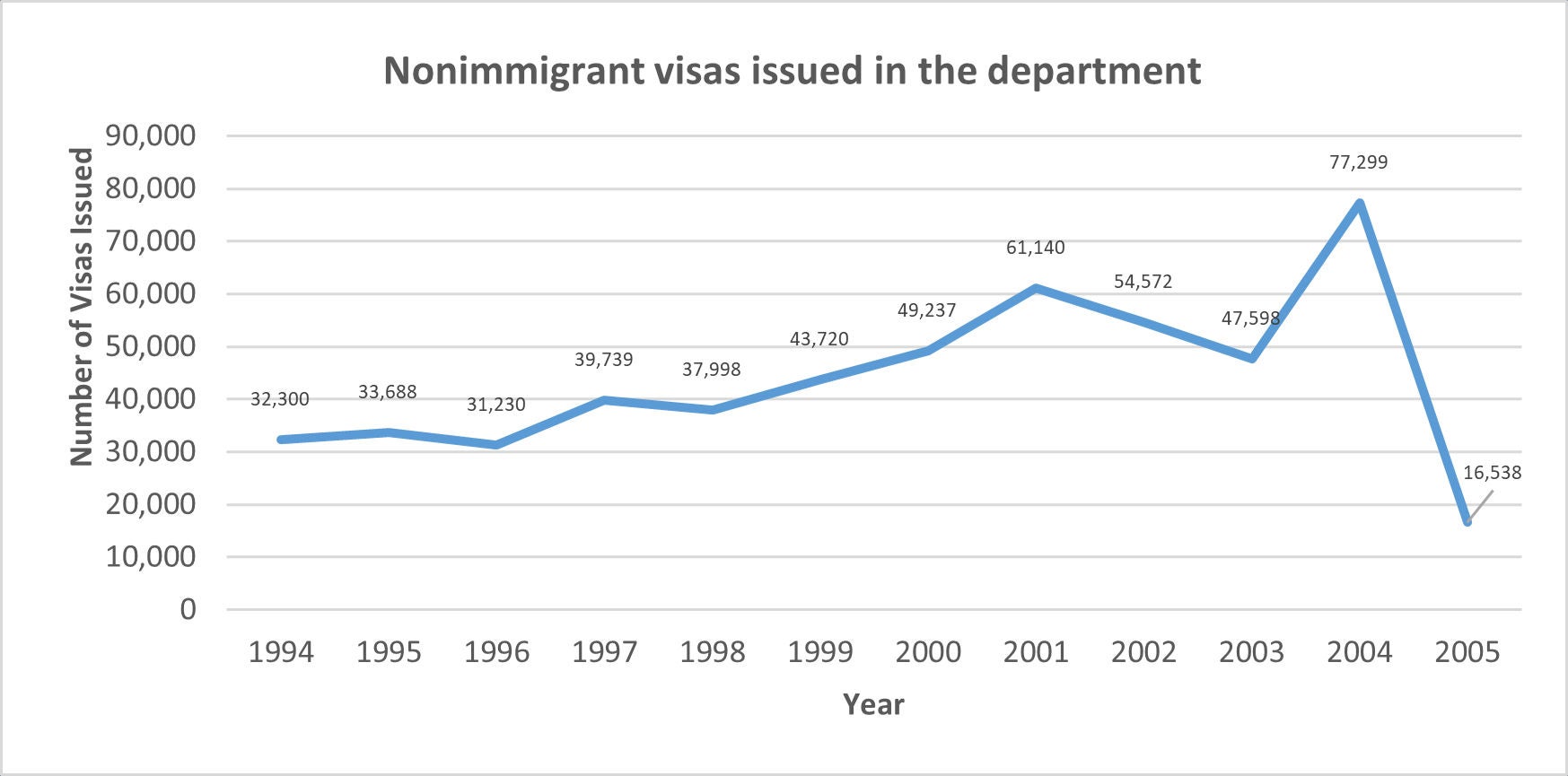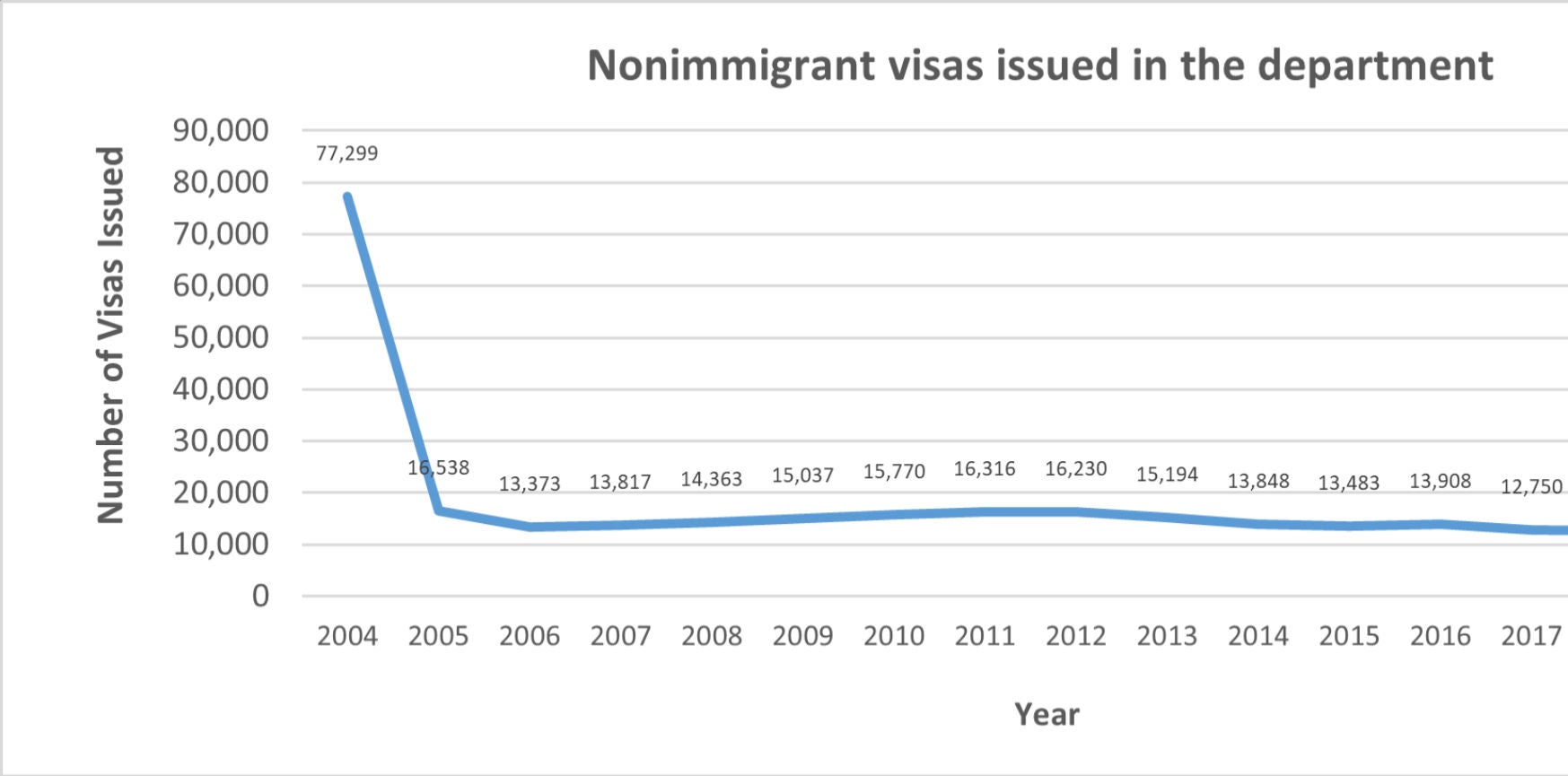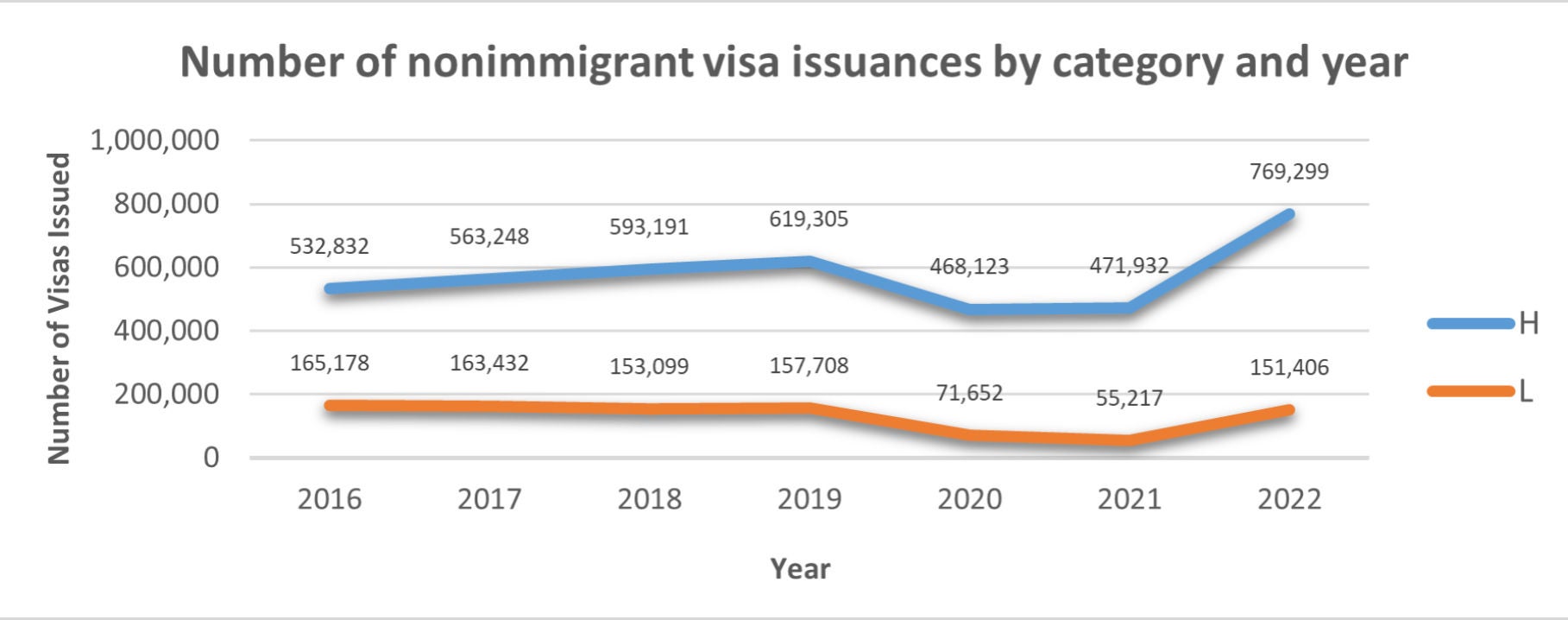Moving forward to 2022, the number of H and L visas issued spiked significantly due to the pandemic backlogs. In 2022, the number of H visas issued jumped to 769,299, while the number of L visas issued was 151,406.25 Whereas in 2020, there were 468,123 H visas issued and 71,652 L visas issued.26 This represents a staggering 61% increase in H and 47% increase in L visas issued from 2020 to 2022.
While consulates have reopened and are attempting to resume pre-pandemic service, they have not been able to keep up with the demand and backlog of visa appointments. We do not anticipate a slowdown in the number of visa issuances for 2023 as the consulates try to make up for the pandemic closures.
It is also interesting to note the impact of these volumes in specific locations. Although so-called visa interview wait times have improved in other countries, India continues to experience longer appointment delays. India has the some of the greatest such delays, with applicants in Hyderabad waiting an average of 136 days and Chennai a staggering 157 day simply to obtain an appointment to be assessed for an H or L visa.27
The President’s Advisory Commission on Asian Americans, Native Hawaiians and Pacific Islanders made several recommendations for how to handle the backlog at US consulates in India, including recommending the revival of the stateside visa revalidation program.28 This may have been the inspiration for the new anticipated visa revalidation pilot program. “The current procedure for restamping H-1B and L-1 visas is to go to a US consulate outside the United States and submit H-1B or L-1 visas, passports and other documents by way of a dropbox or interview.”29 However, with the continued backlogs in visa interview wait times, this procedure is proving to be unduly onerous for visa holders from India.
These significant processing delays are of notable impact because a large number of H and L visas issued are to Indian foreign nationals. In 2022, 282,927 H visas were issued in India, which accounted for 91% of all H visas issued for the region of Asia.30 Similarly, 43,542 L visas were issued in India in 2022, which represents 62% of all L visas issued for the region of Asia.31 Overall, 43% of all nonimmigrant visas issued in 2022 for Indian foreign nationals were for H and L visas.32 Moreover, it is clear that Indian foreign nationals represent a large portion of the overall increase in all H and L visa issuance numbers in 2022.
Recommendations
The number of visa issuances in 2022 is significantly higher than the numbers previously processed at consulates abroad before the pandemic. However, the number of visas issued domestically by the Visa Office has dropped significantly since the visa revalidation program was cancelled in 2004. As a result of the backlog of cases after the pandemic, the DOS will likely face far greater volumes and challenges with the proposed pilot program than was the case when the program was originally offered. As such, and in anticipation that the volume of interested applicants will be very high due to the continued backlogs at consulates abroad, there are numerous considerations that should be made for the pilot program to succeed.
As an overriding factor, it will be important to consider how to narrow the scope of the program to make it manageable to process visa revalidations in a timely manner. Presently, very little is known about the details of the pilot program. At the recent AILA Spring Conference in Washington, DC, the DOS stated that that the pilot program is expected to start in October 2023 and to focus on H and L visas as the main visa categories.33 Additionally, the DOS stated that it will be creating the largest consular section in the world within the United States solely to support this program.34 With the promise of this commitment in mind, several essential recommendations come to mind.
- Rolling out the program in October will be advantageous to visa applicants, as domestic extension processing would then be available to applicants prior to the holidays in December. This step should allow foreign nationals to visit their families without fear of being stranded due to visa wait times.
- As the program will likely involve the mailing in of a passport in support of the application to get the visa stamp, it is important that the DOS attempt to process the applications as swiftly as possible to avoid holding visas for too long. Unreasonable holding periods of these passports would prevent applicants from even having the option of traveling. Assuming it takes eight weeks to process the applications and return visas to applicants, the October 2023 start date should provide ample time to process visas before the holidays in December.
It is also important to recall that the main reason the program was cancelled in the past was due to the difficulty of domestically collecting biometric identifiers. The DOS recently stated, “The possibility of relying on previously collected fingerprints would overcome one obstacle to resuming domestic renewal.”35 With advances in technology, the collection and storage of biometric identifiers digitally would help overcome the obstacle the DOS faced in 2004 that led to the program’s cancellation. - It would make sense to rely on the biometrics collected for the applicants’ initial application to expedite the process and avoid the need for an additional biometrics appointment.
- To expedite the processing of applications, the DOS could consider having an online portal where potential applicants can start an application by filling out a process-focused questionnaire. This proposed document would concentrate on screening and security questions designed to weed out applicants who do not fit the narrow scope of the initial pilot offering. Such an online application portal would help reduce the volume of submissions if such applicants must pass a pre-screening before tendering their application and waste time in mailing in their passport. This recommendation could help streamline the process and reduce the volume of applications the DOS is obliged to process initially.
- Once the applicant limit has been reached, the portal could be designed to close and not accept new applications until the pending applications have been processed. Closing the portal once the applicant limit has been reached would allow the DOS to have time to evaluate the program to identify strengths and inefficiencies for future processing. It would also be a valuable data point in determining whether it is feasible to expand the program further.
- An important consideration that could expedite processing times for the pilot program is security screening. The DOS should consider implementing a security questionnaire like the DS-160 to further narrow the pool of applicants to only those with no criminal history and who have never been subject to an arrest or waiver. This would help ensure applications are processed expeditiously.
The questionnaire could ensure, for example, that the pool of applicants should be limited to those who hold valid H or L nonimmigrant status, have been previously issued a visa at a US consulate abroad and admitted to the United States in the same status they are maintaining, and have a visa that has been expired for 12 months or more. Important security questions could be leveraged from the DS-160 in this questionnaire to ensure applicants have not been subject to removability or inadmissibility in the last five years, been arrested or convicted of a crime, been convicted of an aggravated felony, violated any law related to controlled substances, involved in money laundering/human trafficking/terrorist activities, or any other illegal activity. - The program could be restricted to blanket L visa applicants and focus only on the main applicant. Family members, such as L-2 or H4 applicants, should, in our view, only be included in the undertaking when the program gains traction and has proven to be successful. The program should be limited to a specific number — such as the first 10,000 applicants who apply and meet the requirements to ensure that the Visa Office is able to manage and efficiently process all the applications it accepts as part of the pilot program.
- Beyond the pure mechanics of the program management itself, one further step that could help the program succeed would be to determine where the greatest need lies. This would be best done by looking at what countries have the biggest backlog for interviews and/or have the greatest number of visa issuances.
Due to the large volume of applicants from India and the extensive visa appointment wait times in that country, it would appear to make sense for the DOS to narrow the scope of the program to heavily focus on H and L visa applicants from India. Given the knowledge we have about the hardships that Indian foreign nationals have suffered due to the long wait times and their inability to renew their visas domestically, prioritizing applications from Indian foreign nationals would help alleviate the backlog. In particular, the DOS could choose to prioritize applicants from India who are from the regions of Chennai and Hyderabad, as these issuing offices have the longest wait times in India.
Conclusion
Overall, we believe the revival of the domestic visa revalidation program marks a change in the right direction. In particular, the program as described would help alleviate the backlogs and uncertainty that have arisen since the pandemic. Indian foreign nationals have, in particular, been negatively impacted by the pandemic and their inability to renew their visas in the US. This deliberate program choice has caused many Indian nationals to wait years to see their families, to miss out on important life events and to put their employment at risk if they attempted to depart the country.
We hope the DOS strongly considers prioritizing Indian foreign nationals when determining how to narrow the scope of the program since they account for a large proportion of all H and L visas issued.
We’re optimistic about the possibilities of this pilot program, and hope it is successful and can be expanded and enhanced in the years to come.










